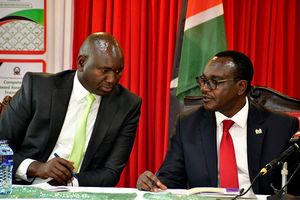
Treasury building, Nairobi.
| File | Nation Media GroupWeekly Review
Premium
Misguided policies: How private sector credit famine affects Kenya's economy
What you need to know:
- Credit to government at 14.7 per cent in 2021 was almost twice its flow in 2011.
- Some 451 State corporations for example held surpluses of Sh84.5 billion while the cost of government domestic borrowing compensating the banks spiked.
Case of the blind leading the blind: Let’s keep it simple, Kenyans are fed many falsehoods on failures of government policies, with justifications that would stand little scrutiny if competence was tested. The sleights of hand never get murkier than in public finance and banking.
They pass under the radar because Wanjiku is often abused in the management of the economy by quacks, while she’s approached or smiled upon only when her all-valuable vote counts. Most of the under-developmental factors and long-term poverty of Wanjiku reside herein without resolution, decade after decade.
In recent weeks, I reflected on Italy’s August 2023 decision and implementation of a windfall tax approximating 40 per cent, imposed on banks’ net interest margin, a measure of the gap between lending and deposit rates. A windfall tax is imposed on unusually ‘above-normal’ gains of enterprises from external circumstances in vital goods and services such as banking (policy hikes in interest rates related to macro-policy) or oil (commodity price volatility).
Italy’s proceeds will alleviate mortgage holders’ cost pressures and pave the way for cutting taxes, resuscitating the public to fight against the cost of living. The government expects to collect about €3 billion (US$3.3 billion).
Longstanding advisories at OP
The move recalled advisories I generated and presented at various interactions in the Office of the President, in 2015. Government now belatedly suggests cutting interest rates, then runs out of steam, instead blowing hot and cold. To its credit in banking, it has now awakened to implementing a migration of public funds it always ‘donated’ (so to speak) to the banking system to trade with, making Italian-style excess profits for many decades, without the whiffs of a windfall tax.
Kenya set up the financial sector for a monumental failure of financial intermediation to support real sector development with credit, especially for rural Kenya where most of the population works and lives. It is to be hoped that the new ‘mopping up’ narrative in banking, with a Treasury Single Account (TSA) is worth more than the rhetoric of November 2022, when the government pledged it would no longer borrow above 10 per cent of interest rates as the stratospheric rates were “unacceptable”.
Yet, months later, gross rates (including tax-exempt securities at CBK (as fiscal agent) escalated to above 20 per cent, annihilating the policy meanings of CBK’s Monetary Policy Committees (MPC) and its work. The rogue rates will of course spike inflation in tandem, with contractionary effects on domestic business investments, employment and economic activity, even destabilizing revenues factored in the contested Budget of 2023/24.
Consider the TSA, hopefully challenging a mutual predatory cohabitation of government and banks lasting for decades, where CBK seemed the pastor blessing the arrangement. Banks could hold public funds as long as they plied the government with securities at auctions, subscribing to government borrowing.
Mopping up government funds from commercial banks is a key reform I described in 2015. In the initial phase of implementing the TSA proposal being resurrected after lying dormant for years, the 2015 analysis probed how to deepen Kenya’s status among emerging economies and middle-income countries; how to rebuild stagnating sectors such as agriculture and industry; how to generate inclusiveness and jobs and reduce poverty with flow of credit to the private sector. The latter was vital to repair broken financial intermediation.
At the time the role of public funds and parastatal surpluses, including well-meaning, costly, and slow-moving funds such as Women’s Fund, Uwezo Fund, and Youth Enterprise Fund as well as some donor program and project funds and even funds meant for public servants’ incentive schemes for housing, health, and allowances, were held in commercial bank balance sheets, and banks took a margin on lending.
The amounts also included substantial lines of credit by donors and other external organisations to support specific sub-sectors such as SMEs. Funds still exist, placed in various banks, forming part of the liabilities side of the cumulative aggregate balance sheet of the commercial banks, an example of which I constructed and presented in a Policy Brief as of December 2014.
In other words, substantial public, and quasi-public deposits formed part of overall banks’ liabilities with public funds conflated with customer deposits in current accounts and savings accounts and sitting on the liabilities side with shareholder funds (called capital and reserves). A very large number of sector-earmarked Public Funds existed (partly reported in the Auditor-General’s reports, for example, 2013/14) and banks traded with the funds (some 8-10 per cent of total bank deposits) making handsome profits.
How handsome? Kenyan bank investors earn some of the highest returns on equity (ROE) and returns on Assets (ROA) in the world, and the profitability of the investments pays other dividends, such as attractive prices of the stocks for NSE-listed banks. Government deposits in the commercial banks, exacerbated by county government deposits since 2010, are estimated at Sh435.87 billion ($3 billion), mostly in demand deposits and some savings deposits, accounting for 8.67 per cent of total bank deposits of Sh5.01 trillion ($34.55 billion).
Some 451 State corporations for example held surpluses of Sh84.5 billion while the cost of government domestic borrowing compensating the banks spiked. These deposits form the liquidity to be migrated to TSA from banks’ liquidity. It is not a mop-up, as alleged. It is a transfer returning the cows to the owner.
Here is the shocker. For decades when the government issued domestic debt in TB and bonds, with promissory payments of returns paid in by taxpayer shillings, government was in effect borrowing its own money and paying interest on it, with taxpayer shillings. The joke is on us that the main beneficiaries were Tier1 banks dominated by foreign banks.
Long-standing funds persist, held as liabilities in the balance sheets of commercial banks, with some due for winding up many years, yet their balances remain as liquidity on the liabilities side of commercial banks’ balance sheets, accessible to convert to assets such as securities and loans to government or to the private sector. Where usable in the balance sheets for payments and general circulation, they generate handsome operating income for commercial banks.
The French have it succinctly: Plus les choses changent, plus elles restent les mêmes: The more things change, the more they remain the same. The proof? Examine the current downward trend of banking credit to the private sector based on IMF, World Bank and OECD data. As the government slices its funds from the banking sector liquidity to the TSA, one would think economic managers had learnt their lesson.
The table tracks key banking indicators, claims on government as per cent of GDP (describing loans to central government institutions net of deposits, as per cent of GDP) and similarly, Credit to the Private Sector. A trend-decline in banks’ credit to the private sector since 2019, is indicated. Credit to government at 14.7 per cent in 2021 was almost twice its flow in 2011. It augers badly for the economic outlook, spiking interest rates, defying the earlier promise to support the private sector with rates not surpassing 10 per cent.
Combined with escalation of taxation and tighter monetary policy, with rates on TBs and bonds spiking to nearly 20 percent, the outlook portrays increasingly wobbly economic policy thinking. Premiums on securities attract lending from banks that take the bait, but on short-dated durations, while external lenders keep a distance. The economy could contract with lower investment, output, revenues to KRA, and employment, all with multiple impacts posing a challenge to an already contested Budget exercise of 2023/24.
The puzzle is: Rate hikes won’t mend inflation caused by layoffs or feed hungry people facing increased poverty. It is not demand-driven. Those who prime the rates misdirecting their firepower on monetary policy are only re-purposing it to a tool to pull in funding for government expenditures, not economic management. They should back off from wielding hikes like knives.
Dr Wagacha, an economist, is a former Central Bank of Kenya chairman and adviser of the presidency




